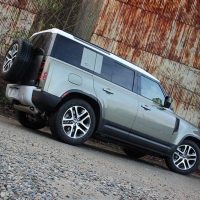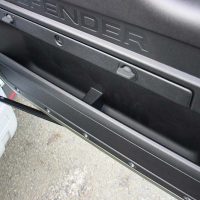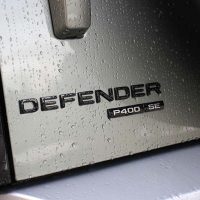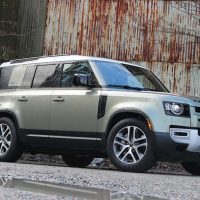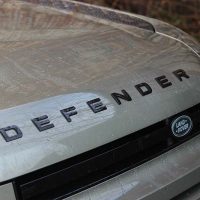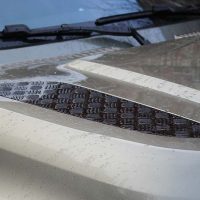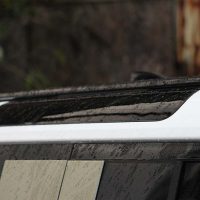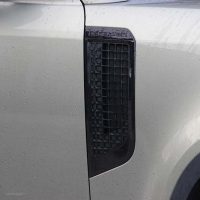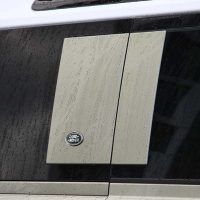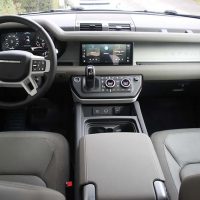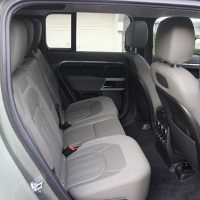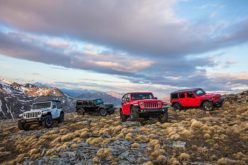After an almost 25-year hiatus, the Land Rover Defender has made its way back to North America, and with it, we get to experience the latest evolution – more of a revolution, really — of one of the most famous nameplates not just in the SUV world, but in the automotive world in general.
For the uninitiated: the 2021 Land Rover Defender’s ancestry can be traced all the way back to the late ‘40s, when Britain was tired of having to rely on the Americans to provide Willys MB JPs (or “jeeps”) for their military and decided to create something they could call their own. In addition to that, the Defender became one of the first civilian vehicles available with four-wheel-drive. Land Rover also used aluminium for their bodies, which is also the case for the new model.
Fast-forward to 1983, and after a series of evolutions, the “new” Defender was born, looking more modern than the older vehicle — which had looked pretty much the same for about 40 years. Even though the ladder-framed Defender’s ride was choppy, it wasn’t all that fast and both head- and legroom were on the wrong side of “generous,” it has achieved cult status in North America like few other SUVs this side of the Jeep Wrangler and perhaps the Ford Bronco.
And now, the Defender is back in both long-wheelbase 110 and short-wheelbase 90 forms, and it’s both like and unlike Defenders of old.
In Canada, we have two engine choices, both turbocharged: a four-banger good for 296 horsepower and 295 pound-feet of torque in P300 form, and a six-cylinder with some mild hybrid functions good for 395 hp and 406 lb-ft in P400 form, as seen here. The Defender has always been known for its diesel power, though, and while a diesel version does exist, we won’t be seeing it here.
Styling-wise, they’ve nailed it, right on the head – sort of. The boxy profile; the LED headlights; the “portholes” on the roof; the “Pangea Green” paintjob and the white roof (a $1,010 option, but still) that recalls Landies of old that had no air con and relied on white roofs to keep it cool inside; all beautifully executed.

Now, the “sort of” bit: the $1,350 20-inch wheels on my tester are a bit of a thorn in my side as well, in that they look way too modern for this truck; they’re fine for a Discovery or Range Rover Velar I’m sure, but not the Defender. A Defender needs body-coloured steelies and while you can get them, they’re reserved for the lower trims and their smaller brakes because that’s the only way they’ll fit. Shame.
Once inside, it’s again very Defender-y and very not; in the “not” sense, well, there’s headroom. Lots of it. There’s also legroom, as well as a heated steering wheel, the latest in Jaguar-Land Rover’s infotainment technology (centred around a low-profile 10-inch display that feels just as responsive to the touch as your tablet does), digital rear-view mirror and Meridian audio; I have a feeling that in the older Defender, you’d be lucky to get FM audio. It’s airy, it’s spacious, it’s quite techy and it’s high-class where it needs to be, and just a little rugged otherwise.
The seats are adjustable a number of ways and heated – but they’re a little flat and high-mounted and in my tester, finished in a very mil-spec olive drab colour with both leather and a sort of cut-proof-seeming nylon that you’d need if you were to have a bowie knife on your hip. Which you very well could, in a vehicle like this. I love them.
There’s even a third row – but barely. It’s incredibly snug and I couldn’t justify stuffing an adult back there unless I had a real axe to grind with them. Save the $2,300 required to get that feature. Plus, if you really want some extra seating, you can go super basic and scrap the centre console with its wireless charger and optional cooler, and have – wait for it – a fold-down seat there instead. That’s right; the front row…can be a bench seat, just like in the ’87 Cutlass Ciera my wife used to drive.
Then there’s the “barn-door” style tailgate. It’s heavy and it opens from left to right, meaning that when parked on the right side of the road – as you would be in almost every country in the world but not, coincidentally, the Defender’s home country of England – the door opens against the curb. That means that you have to be sure to leave room between yourself and the car behind you and even then, you may have to walk around the front of the Defender to get to the tailgate. There’s a big opening once the door is open, though, and you can operate the Defender’s adjustable air suspension system from buttons mounted inside the tailgate for a lower liftover height.
That’s enough about the foibles and quirks; let’s get on to what I like about the Defender, and that starts with the cost of entry. You can get into the 110 for less than 70 grand – 70 grand! – assuming you can live with the four-banger. Getting the six-cylinder will run you just over 75 grand at base, but even that’s not so bad considering that with it you get air suspension, adaptive dampers, hill-descent control, LED head- and taillights, dual-zone climate control, interior mood lighting, 360-degree parking aid, leather seats, bigger brakes and more. It’s a great deal and to be honest, the one option my $89,000 tester had that I really would want is that contrast-colour roof.
The drive experience starts with that great powertrain. Power is shifted to the four wheels through a quick-shifting eight-speed automatic transmission, the engine and transmission working well together in unison to maintain surprisingly brisk forward progress. On the road, meanwhile, the adaptive dampers and air suspension do a proper job of keeping everything copacetic; all but the harshest bumps are metered out, and you have to lay some of the blame at the feet of my tester’s big wheels for that.
The real take-home for me, though, when it came to the urban grind, was just how easy the Defender was to manoeuvre through tight situations. They’ve tuned the steering just so, and the view out is so good that parallel parking spots I felt would involve a lot of wheel turning were never as bad as I thought they’d be. It’s a masterclass in size management, that’s for sure, because the 110 is not a small SUV by any means.
Off the beaten track, meanwhile, the Defender acts as you knew it would; the four-wheel drive system is an impressive one that provides plenty of wheel articulation and the well-tuned steering does its part here as well to provide a ton of confidence as you cross more rugged terrain. There are, of course, a number of drive modes – six, to be precise – that adjust throttle mapping, traction control, transmission response and suspension travel. There’s also a way-cool feature that uses cameras to basically make your hood disappear, so you can see what’s going on below you when off-roading. It’s all very tech and un-Defender, but darned if it isn’t effective.
Equally effective is the air suspension, and its ride height that can be changed on-the-fly to allow anywhere from 8.5 to 11.5-inches of ground clearance, helping achieve a 900 mm wading depth. This is a truck that’s meant to be taken off-road.
The pros so outweigh the cons here that this vehicle is a clear win for Land Rover, a company that, along with Jaguar, has had a rough go as of late. The Defender, however, is a vehicle tailor-made to handle the rough stuff and it could very well be the shot in the arm that the company needs. I love it, and I want one.
Now, about those steelies…








